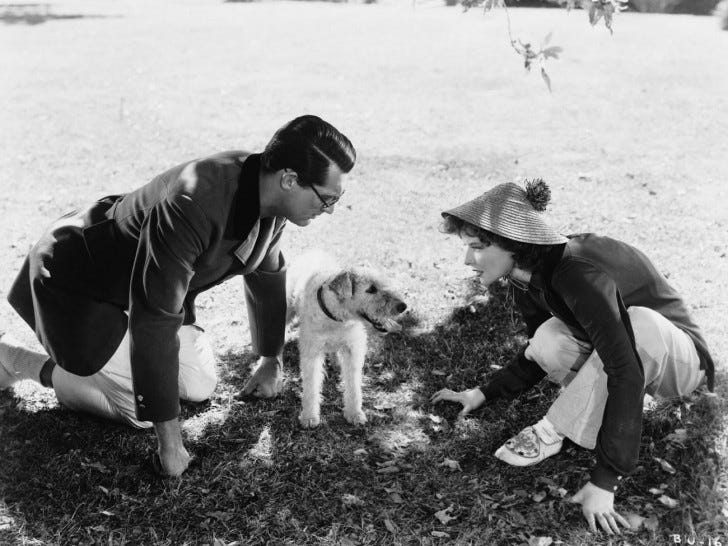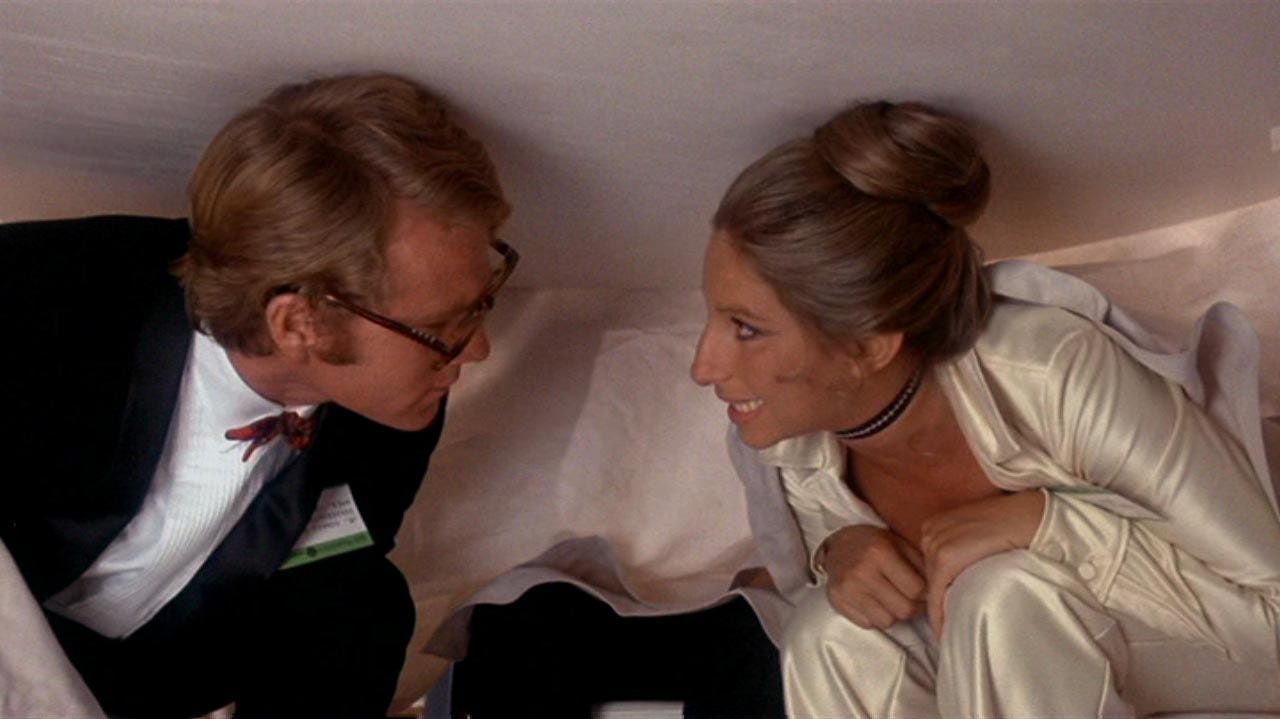A great screwball comedy is a uniquely liberating experience. They acknowledge that life is absurd and chaotic, that everyday occurrences can snowball into anxiety-ridden panic, that finding an uninterrupted moment to tell someone how you feel can become a Sisyphean task, and then they heighten all of that into great manic comedy. Screwball comedies are about our most chaotic behaviors and about life careening off the rails; personal and professional obligations anxiously ignored for love, freedom and excitement.
Bringing Up Baby is perhaps the purest example of this kind of screwball comedy. Directed by Howard Hawks, it stars Cary Grant as a paleontologist working to get a million-dollar grant for his projects, and Katharine Hepburn as the eccentric woman who seems dead set on ruining Grant’s marriage engagement and squandering his chance at securing that funding. The Baby of the title is a pet leopard that arrives at Hepburn’s apartment one day — a bizarre, unexpected gift from her brother, who lives in Brazil. Hepburn believes Grant is actually a zoologist and so, through a lot of persistence, she convinces Grant to help her take the leopard up to her aunt’s farm in Connecticut. There’s simply a lot of fun to be had watching Grant and Hepburn react to an actual leopard as it walks dangerously close to them or hangs out in the back of their car. Philosophically, the leopard represents the unpredictability and the danger that lies at the heart of the screwball comedy. Its presence makes little logical sense, and to spend too much time with it is to resign yourself to a life of danger, and yet, there doesn’t seem to be any other way to proceed; the same is true of Grant’s relationship with Hepburn.
In execution, Bringing Up Baby is 100 minutes of two of the screen’s most elegant stars stooping to increasingly ridiculous levels of silliness. The film’s greatest sequence involves Grant and Hepburn chasing a dog named George because George has taken Grant’s rare dinosaur bone and buried it somewhere on the Connecticut property. Grant and Hepburn run through the house in such a stilted, oddly angular manner, and the staccato way they yell, “George! George!” is utterly ridiculous (Doubly so when Grant complains that Hepburn “Sounds like an echo,” so she starts to yell, “Nice George! Nice George!” instead). Later, Grant ends up in the yard next to the dog, both of them digging through the dirt together. It’s important that Hawks repeatedly puts his stars into animalistic, somewhat embarrassing positions; love and ambition turn us into fools.
Bringing Up Baby is the most prominent influence on Peter Bogdanovich’s 1972 homage to the screwball comedy, What’s Up, Doc? The film stars Barbra Streisand and Ryan O’Neal in a plot similar to that earlier film — he’s a musicologist in San Francisco trying to secure a grant for an important research project, and she’s the unusual woman following him around and causing trouble, and they both end up involved in some convoluted business involving four identical briefcases being passed around a hotel.
Like Hawks with his elegant stars, Bogdanovich clearly delights in seeing Streisand, already Hollywood royalty after winning an Oscar for Funny Girl, in this incongruous role as a destructive Bugs Bunny type (early on, she’s seen munching on a carrot while exclaiming the title phrase). Additionally, Bogdanovich puts Ryan O’Neal in a similar pair of glasses as Cary Grant’s, and has his character obsess over a pile of igneous rocks in the same way that Grant obsesses over a rare dinosaur bone in Bringing Up Baby. The comedy is familiar but, perhaps as a reflection of the chaotic America of the early 70s, also much more cartoonish and destructive. One sequence involves O’Neal inadvertently torching an entire hotel room, and the climactic set piece is a chase through San Francisco where O’Neal and Streisand narrowly escape death while demolishing anything in their path. If a key characteristic of the screwball comedy is that its leads are more manic than the people around them, here Bogdanovich presents us with an entire manic city.
Before he was a filmmaker, Bogdanovich was a film critic. In 1962 he organized a retrospective of Hawks’ films at the Museum of Modern Art in New York, which helped inspire American critical interest in Hawks’ work. All of Bogdanovich’s films are inspired by and in dialogue with old Hollywood filmmaking in some fashion, but his approach was never about revisionism (Unlike his contemporaries Martin Scorsese, who turned the MGM dream factory style into a nightmare with his downbeat musical New York, New York, or Robert Altman, whose western McCabe & Mrs. Miller and noir The Long Goodbye poked holes through the myths of prominent Hollywood genres). Instead, while dealing with subject matter that old Hollywood films could not, Bogdanovich faithfully recreates the style and, more importantly, the tone of the Hollywood movies he loves so that, for example, the characters in his films are as rich and lively as the ones you'd find in the films of Howard Hawks.
Bringing Up Baby is not the only screwball that Bogdanovich’s film references: the courtroom finale is reminiscent of My Favorite Wife; an impromptu duet between Streisand and O’Neal recalls Irene Dunne and Ralph Bellamy singing together in The Awful Truth, as well as the musical performances in Hawks movies like Ball of Fire; the constantly opening and closing doors in the hotel hallway are a successful imitation of the rhythms of Ernst Lubitsch’s work; and maybe there’s a touch of Mitchell Leisen in the gesture of O’Neal reclining his seat on a plane to kiss Streisand in the row behind him. But these old Hollywood reference points are crossed with a distinctly modern sensibility, owing in part to writers Buck Henry (who scripted one of the films that helped usher in the New Hollywood, The Graduate) and Robert Benton and David Newman (they co-wrote Bonnie and Clyde, the other key New Hollywood film), who add some edginess to the movie’s nostalgic sense of humor. There’s also the presence of the great Madeline Kahn, best known for her appearances in Mel Brooks’ Young Frankenstein and Blazing Saddles, who gives a powerhouse performance as O’Neal’s irritating fiancée Eunice.
Intuitively, Hawks and Bogdanovich understood that it’s deeply satisfying to see beautiful people engaged in the silliest possible hijinks — a truism that’s sadly lacking in today’s cinema. It’s very funny that both directors made their astonishingly handsome leading men wear glasses in order to give them the appearance of being anxious, aloof nerds, but I think there’s some truth in this, too — these characters straddle the line between movie star ideal and the messiness of regular life, and maybe all it takes for us to live like a bespectacled Cary Grant or Katharine Hepburn is that one daring step into the unpredictable. I’m reminded, as I often am, of a Jens Lekman lyric: “I can sit and watch my life go by or I can take a tiny chance.” In the heightened world of the screwball comedy, where every decision and encounter spirals into the chaos, the only thing you can do is take that chance.


